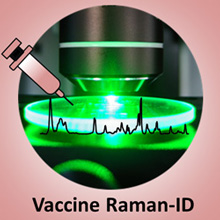Raman spectroscopy allows fast analysis of vaccines

The Raman spectroscopic signature contains information of all the components in the vaccine and can be used for quick identification using machine learning. Friedrich Schiller University Jena
The production of vaccines is time consuming and requires high quality controls to guarantee quality, safety and efficacy. Even vaccines against a single pathogen consist of different components or substances. Components of combination vaccines are even more complex.
Each vaccine has a characteristic composition. The vaccines are tested for their components, their quality, efficacy and safety both during production and before marketing authorisation within the scope of the mandatory batch testing by the PEI.
PEI researchers around Prof. Dr. med. Isabelle Bekeredjian-Ding, Head of the Department of Microbiology, in collaboration with scientists from the Friedrich Schiller University Jena and the Leibniz Institute for Photonic Technologies headed by Prof. Dr. Jürgen Popp investigated to what extent Raman spectroscopy can be used for the identification and differentiation of vaccines.
In Raman spectroscopy, molecules or solids are exposed with laser light. The inelastic scattering of the light and the associated differences in frequency with the incident light allow conclusions to be drawn about the examined substance.
The so-called molecular fingerprint allows the quick and easy identification of any molecule. The method is used, for example, to study the material properties of semiconductors or for infection diagnostics. The process is also used in the quality control of chemical medicines (tablet form), in drug manufacturing (fermenter) and for the identification of counterfeit medicines.
Researchers applied Raman maps to analyze specific Raman signatures from air-dried samples of combination vaccines containing antigens from tetanus, diphtheria, and pertussis (DTaP vaccines). In fact, the vaccines could be identified and distinguished using these specific signatures.
The investigations confirm that Raman spectroscopy can be used to analyse and classify manufacturer-specific vaccine preparations as an analytical method. The results provide a good starting point for the development of a simple and reliable test system for vaccine identification and quality contr
Silge A, Bocklitz T, Becker B, Matheis W, Popp J, Bekeredjian-Ding I (2018). Raman spectroscopy-1 based identification of toxoid vaccine products.
NPJ Vaccines 3, Article number: 50 (2018) https://doi.org/10.1038/s41541-018-0088-y
https://doi.org/10.1038/s41541-018-0088 to the article
https://www.pei.de/EN/information/journalists-press/press-releases/2018/20-raman… This press release on the Paul-Ehrlich-Institut Website
Media Contact
All latest news from the category: Life Sciences and Chemistry
Articles and reports from the Life Sciences and chemistry area deal with applied and basic research into modern biology, chemistry and human medicine.
Valuable information can be found on a range of life sciences fields including bacteriology, biochemistry, bionics, bioinformatics, biophysics, biotechnology, genetics, geobotany, human biology, marine biology, microbiology, molecular biology, cellular biology, zoology, bioinorganic chemistry, microchemistry and environmental chemistry.
Newest articles

A universal framework for spatial biology
SpatialData is a freely accessible tool to unify and integrate data from different omics technologies accounting for spatial information, which can provide holistic insights into health and disease. Biological processes…

How complex biological processes arise
A $20 million grant from the U.S. National Science Foundation (NSF) will support the establishment and operation of the National Synthesis Center for Emergence in the Molecular and Cellular Sciences (NCEMS) at…

Airborne single-photon lidar system achieves high-resolution 3D imaging
Compact, low-power system opens doors for photon-efficient drone and satellite-based environmental monitoring and mapping. Researchers have developed a compact and lightweight single-photon airborne lidar system that can acquire high-resolution 3D…





















